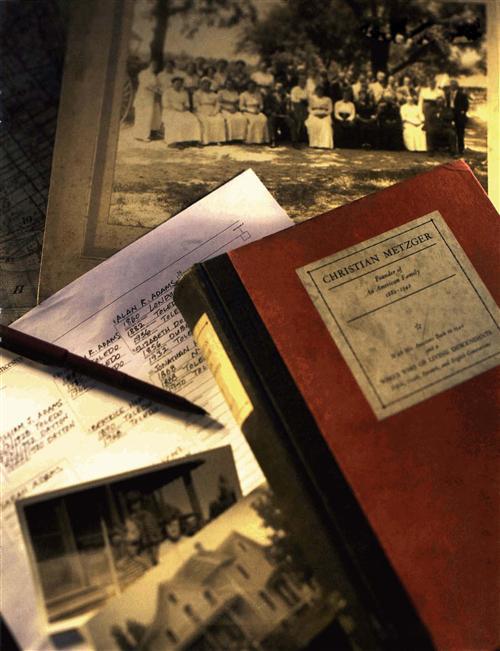In the 13 years that I’ve been teaching family history classes, it never fails: On the first day, one of my students always announces something like, “My family history is done on my mother’s side. My Aunt Martha wrote it.” Although I’m still amazed by this declaration — since no one’s family history is ever “done” — it’s nice to know that a relative took the time to write a piece of the family history.
Maybe someone has written a family history about your ancestors, too. A “genealogy cousin,” related to you by a common ancestor umpteen generations back, might have compiled and published a book about your family. Though such a book may not include every descendant down to your parents or grandparents, it could help you connect to another generation. If a published genealogy exists, it can save you countless hours of research. (It also could create countless hours of research if you discover the genealogy has flaws and wasn’t well-researched.)
How can you find out whether your family history has been published — and how do you get your hands on a copy? How should you analyze such research? Let’s take these questions one step at a time.
Published sources
Finding a family history book that covers part of your ancestry starts with knowing where to look. Here are 10 likely sources where you might locate a published genealogy about your family — if one exists:
1. The Family History Library: Located in Salt Lake City, the Church of Jesus Christ of Latter-day Saints’ massive Family History Library (FHL) <www.familysearch.org> has more than 70,000 biography and family history volumes. You can search its online catalog by several categories, including surname. The results could provide a list of books that focus specifically on your family, and others that cover your surname as an “allied” branch. (But remember: Some books in the list could refer to unrelated families that share your surname.) To access the catalog, go to the FamilySearch home page and click the Library tab, then Family History Library Catalog, then Surname Search. You also can search the catalog at your local Family History Center (FHC), a branch of the FHL.
If you find a published genealogy at the FHL and it’s been microfilmed, you can order the film through your FHC. If it hasn’t been microfilmed, you’ll need to visit the FHL or have a local researcher check the book for you.
2. Public libraries with genealogy and local history departments: Many public libraries with genealogy and local history collections now make their catalogs available online. (For a guide to finding family history resources in online library catalogs, see the Family Tree Magazine Yearbook 2004 special issue , and check out <www.familytreemagazine.com/articles/librarylinks.html>. At <www.publiclibraries.com>, you’ll find links to libraries listed by state.) Look for an online catalog for a library near the place your ancestors lived, then check to see if it has any published genealogies on your family. One major genealogy department — the world’s second-largest genealogy collection, in fact — is at the Allen County Public Library in Fort Wayne, Ind. <www.acpl.lib.in.us/genealogy>. It owns 50,000 family histories.
3. Genealogical and Local History Books in Print: A great resource for determining if there’s a published history of your family is the four-volume set Genealogical and Local History Books in Print, 5th edition, edited by Marian Hoffman (Genealogical Publishing Co.). The volumes cover family histories, general reference books, US sources on places in Alabama through New York and US sources on North Carolina through Wyoming. Unfortunately, the family history volume, which contains 4,600-plus listings dating up to its 1996 publication, is out of print — but you’ll find it at most libraries with genealogical collections. Each listing in this resource gives a brief description of the book, price and ordering information.
Remember: If your family history was out of print when Hoffman compiled this book, it won’t be listed. To find an out-of-print genealogy, check online used- and rare-book search services such as Alibris <www.alibris.com>, Bibliofind <www.bibliofind.com>, BookFinder <www.bookfinder.com> and Powell’s Books <www.powells.com>. Cyndi’s List has links to online used-book stores at <www.cyndislist.com/books.htm# used>. Also search online auction sites such as eBay <www.ebay.com>.
4. Library of Congress: Theoretically, once someone has written a family history book, he or she should register it with the Library of Congress Copyright Office. To register, a writer must send two copies of the work with an application and fee. Once the copyright is approved, the book is donated to the library’s genealogical section. Marion Kaminkow’s Genealogies in the Library of Congress: A Bibliography and its supplements consist of five massive volumes (Genealogical Publishing Co.). In these volumes, which are available at libraries, you’ll find details on more than 50,000 family histories — published and unpublished — at the Library of Congress. You also can check the library’s online catalog <catalog.loc.gov> for published family histories.
5. Directory of Family Associations: You might check Elizabeth P. Bentley’s Directory of Family Associations, 3rd edition (Genealogical Publishing Co.), as well. This directory will tell you if the family association you’re interested in has any publications. Even if you don’t discover a family history book, you could uncover an association newsletter or journal containing genealogies of different branches of your family.
6. Genealogical periodicals: Sometimes a researcher doesn’t have enough material to fill a book, so she’ll write the family history as an article and submit it to a genealogical journal. At the FHL, your local FHC or a large genealogical library, ask for the Periodical Source Index, also known as PERSI (pronounced purr-see). PERSI lists names found in more than 6,000 genealogical and local history journals published in the United States and Canada since 1800. You can access PERSI at libraries that subscribe to Heritage-Quest Online <www.heritagequestonline.com>. PERSI‘s also available in print through 1985 and as part of Ancestry.com’s <Ancestry.com > US Records Collection subscription. You can buy the 2000 and 2001 editions (covering all years) on CD-ROM from Ancestry.com, too. Search PERSI for your family surnames or place names. Once you have the article and periodical titles, ask if the library has that publication.
If not, you can order the article through interlibrary loan from your public library, or from the Allen County Public Library, which created PERSI. Write to the Allen County Public Library Foundation, Box 2270, Fort Wayne, IN 46801, for the current photocopying fee and an order form, or download the form online by following the links at <www.acpl.lib.in.us/genealogy/persi.html>.
7. County and local histories: Although not considered published family histories in the strict sense of the term, county and local histories might contain biographical or genealogical sketches of the area’s first settlers and contemporary residents — possibly including your ancestors. To help fund these hooks, publishers often invited locals to submit short narratives (and sometimes photos) of themselves or their ancestors, which they’d print in the publication for a fee (kind of like the paid birth and death announcements in modern newspapers). Typically, little or no research went into these biographies and genealogies; they contain what family members knew about their ancestry from family traditions. Still, some are fairly accurate and reliable — and they might hold valuable clues you won’t find elsewhere. Check United States Local Histories in the Library of Congress: A Bibliography edited by Jack Kaminkow (Genealogical Publishing Co.) for the library’s 90,000 local histories up to 1972. The fifth volume is a supplement listing histories from 1972 to 1976, plus an index and corrections to the other volumes.
8. Commercial genealogy Web sites: Genealogy.com offers two subscription collections containing published genealogies — both of which let you instantly search the books’ content for references relevant to your family, instead of scouring each tome page by page. Genealogy Library <www.genealogy.com/glsub.html> has more than 1,900 digitized family histories (many trace Colonial immigrants’ descendants); it costs $9.99 a month or $49.99 a year. The Family 8c Local Histories collection <www.genealogy.com/hqosub.html> includes 16,000 titles dating back to 1700. The books come from the United States, Canada and the British Isles. A subscription costs $14.99 per month or $79.99 per year. You also can access this collection for free at libraries that subscribe to HeritageQuest Online.
9. Family Web pages: You also might discover entire family histories online. Some researchers find that it’s more cost-effective to publish their genealogies electronically on their own home pages. You can search for family history Web pages at such sites as <www.genealogy.com> and <www.familysearch.org>. Or scour the entire Web using search engines such as Google <www.google.com> or AlltheWeb <www.alltheweb.com>. Type in your ancestors’surnames plus keywords such as genealogy or family. To refine your results, choose the advanced-search feature and enter your query with Boolean search terms — for example, Smith and “family history” or Smith and genealogy. See the February 2004 Family Tree Magazine for more search-engine strategies.
10. Aunt Tilda’s attic: Even if you don’t find a reference to your surname in one of these sources, a written family history still could exist. When Great-aunt Tilda recorded the family saga, she might have made a limited number of copies, available only in some obscure research repository or at the bottom of a trunk in het attic. The “book” may be no more than spiral-bound photocopied pages that Tilda distributed just to family. Be sure to ask all your relatives if they’re aware of any such family history. Typically, however, authors today who go to the trouble of compiling a family history will make it known and available through at least one of the avenues outlined here.
Book reviews
Finding a published family history book that includes a branch of your family tree doesn’t necessarily mean you’ve hit the genealogy jackpot. Remember the old adage: Just because you see it in print (or on the Internet) doesn’t make it true. You need to evaluate whether the information in the book is reliable and accurate. Look for reviews of the work in respected journals and newsletters, such as the National Genealogical Society Quarterly and the Federation of Genealogical Societies’ Forum. Reviews usually appear within a year or two of the book’s publication and give insight into the work’s strengths and weaknesses. (These publications also are indexed in PERSI, so your search there — described on the previous page — should turn up relevant reviews.)
When you have the book in hand, look to see if it’s documented — that is, did the author cite a source for each fact? Then check some of the author’s sources yourself. Are you able to find a document based on information in the footnotes or endnotes? Reputable genealogists always include references so other researchers can acquire the documents themselves. If you have trouble locating a document using a reference, the author probably wasn’t careful about citing sources.
Where they overlap, compare the published genealogy’s facts with those from your own research — particularly the information you have that’s most solidly based on primary sources. If the book you’ve found says that a common ancestor was born in 1890, but your photocopy of the birth certificate clearly says 1905, you might take other “facts” in the book with a grain of salt. How does the published genealogy match what you know from census records? When its information is added to yours, do you get children born before their grandparents or when their parents were several years deceased?
Let’s look at an example of evaluating published genealogy information. The History of Elbert County, Colorado by Margee Gabehart (Curtis Media), contains a sketch of the Ernst Wedemeyer family on page 203, which reads in part:
Ernst was bom Dec. 23, 1848, in Luthorat Umt Finbeck, Hanover Province, Germany, to Ernst and Johanna Kubster Wedemeyer…. Ernst left Germany to escape conscription into the Prussian Army…. Ernst Wedemeyer became a citizen of the United States on Sept. 13, 1870, having reached Central City, Gilpin County, Territory of Colorado.
Just as with published family histories, you need to evaluate the information in a county history’s biographical sketch for accuracy. I located a published transcription of the Gilpin County, Colo., naturalization records for 1863 to 1910. Sure enough, I found Ernst Wedemeyer, and he became a citizen on Sept. 13, 1870. I’ll check other information in the sketch, and if those facts prove similarly reliable, I’ll accept the sketch as accurate.
Here are some points to keep in mind when evaluating published genealogies:
•Check the sources. A questionable genealogy perpetuates errors from other published sources or fails to properly cite the sources.
•Consider the source material. Does the book rely heavily on other published sources, databases or Web sites? Or did the author do original research, citing documents such as wills, deeds, censuses and vita! records?
•Try to find all reviews written about the book. Don’t rely on one reviewer’s opinion.
•Watch for mismatching facts. Does the published genealogy have information that conflicts with what you’ve learned about your family from other sources?
•Be sure the dates make sense. For example, a woman born in 1870 can’t give birth in 1875. A man born in 1742 wouldn’t be getting married in 1753.
•Look out for typographical errors. If the author wasn’t concerned with proofreading, was he or she concerned about the accuracy of the genealogy data?
Remember: Finding published genealogies is a starting point, not the end of your research. Even if the book is well-documented and the information is sound, no family history is comprehensive. Despite what Aunt Martha compiled on your mother’s side, no one’s genealogy is ever “done.” You’ll always have branches and surnames to pursue that aren’t covered in one book.
Look for published genealogies for all of your lines. Just use them cautiously, not as gospel, until you verify the information.
• The Hatch and Brood of Time: Five Phelps Families in the Atlantic World, 1720-1880 by Peter Hating Judd (Newbury Street Press)
From the September 2004 Trace Your Family History.




